Czech Vánočka is a festive delicacy that captures the essence of Christmas in the heart of the Czech Republic. Everyone knows: When homemade Vánočka comes out of the oven, Christmas is on the doorstep!
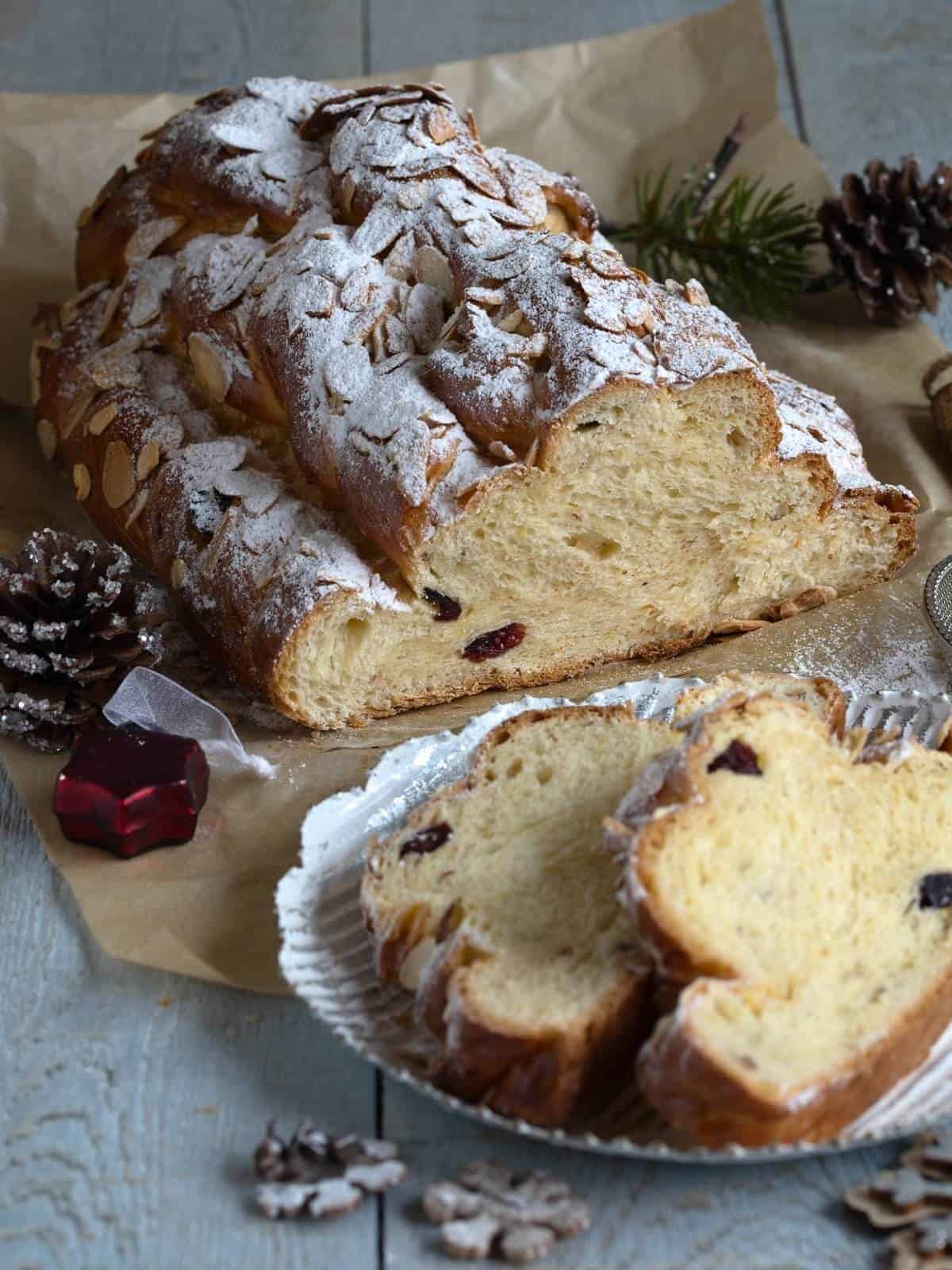
DISCLAIMER: This is a new, November 2023, revamped recipe. The original recipe from January 2021 can be found in PDF format here.
➜ What is Vánočka
Czech Vánočka, or Houska (Hoska) in the old way, is a sweet braided bread traditionally baked during the Christmas holidays. It is made from yeast dough, braided into a long bread loaf shape. Vánočka contains ingredients such as raisins, almonds, and sometimes even citrus zest, resulting in a delicious treat that is both symbolic and tasty.
This traditional Czech sweet bread is supposed to look like Baby Jesus wrapped in a swaddling blanket, which is why Vánočka is a symbol of new life and fertility.
⤍ Vánočka tastes best sliced with butter and a little jam on Christmas morning. Add white coffee or cocoa, and you have the typical holiday breakfast!
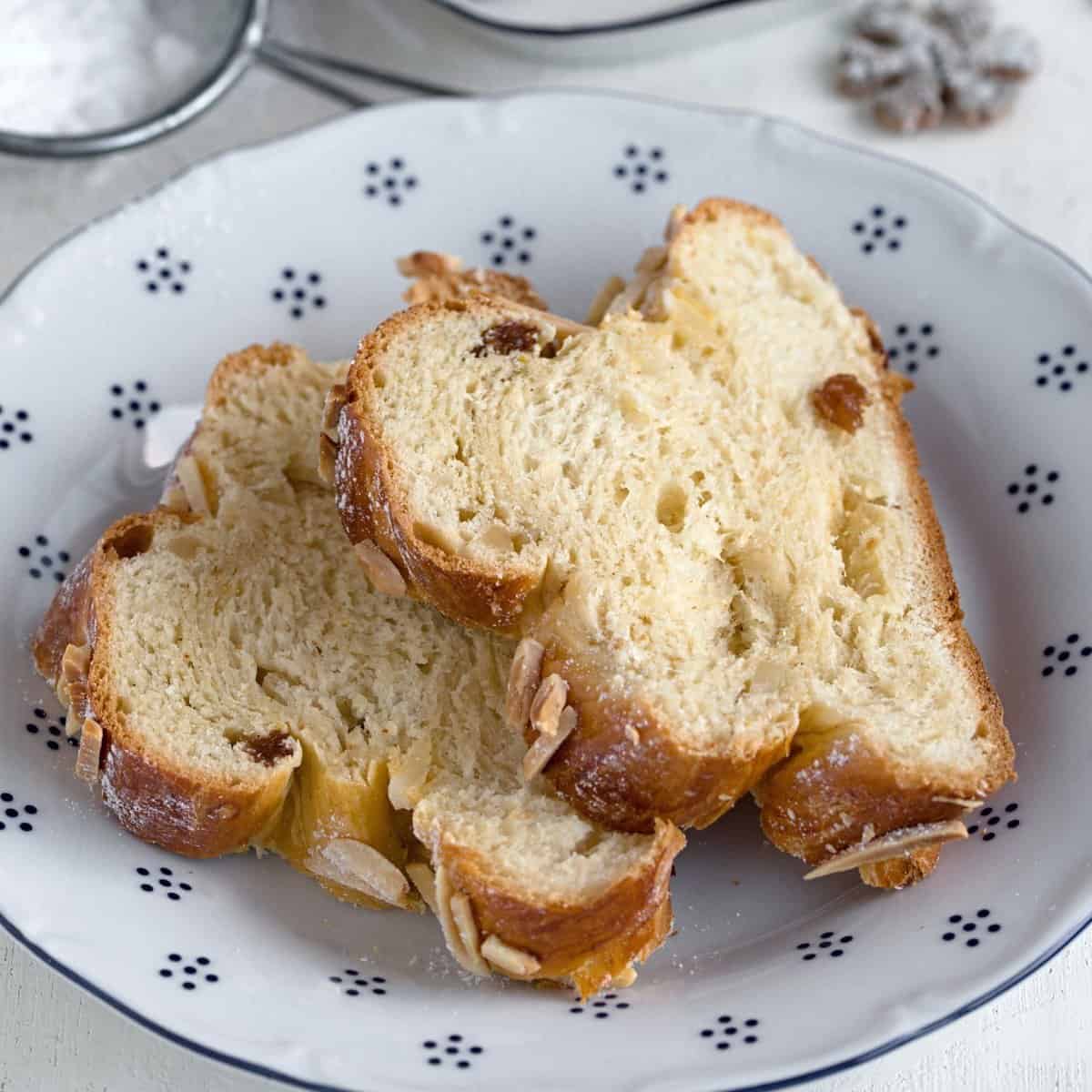
Also, take a look at my Mom's Vánočka recipe!
➜ History
If you are an American with Czech roots, you may know Vánočka as Houska or Hoska.
It's because, historically, Vánočka was called Houska. It was only later that this name started to mean a different kind of pastry. These days, the name Houska in the Czech Republic means much smaller, savory braided white bread, widely available in the Czech stores.
Look at what the Czechs call Houska currently.
Many Bohemians and Moravians migrated to the USA at the turn of the 19th and 20th centuries, when the Vánočka was still called Houska. This name was carried over to the USA by Bohemian emigrants and is still used by their descendants.
That's the reason why modern Czechs call the Christmas bread Vánočka, while the name Houska might be more common in the USA.
FUN FACT: Other names for Vánočka used in certain Czech regions are Calta, Vandrovnice, or Štědrovnice.
The term Štědrovnice comes from North Bohemia (Jizera and Krkonoše Mountains), where I live with my family!
More Czech stuff to explore: What do Czechs eat at Christmas
➜ Ingredients you need to bake Vánočka
✅ You will find the exact ingredient amounts in the recipe card below, which you can also print out.
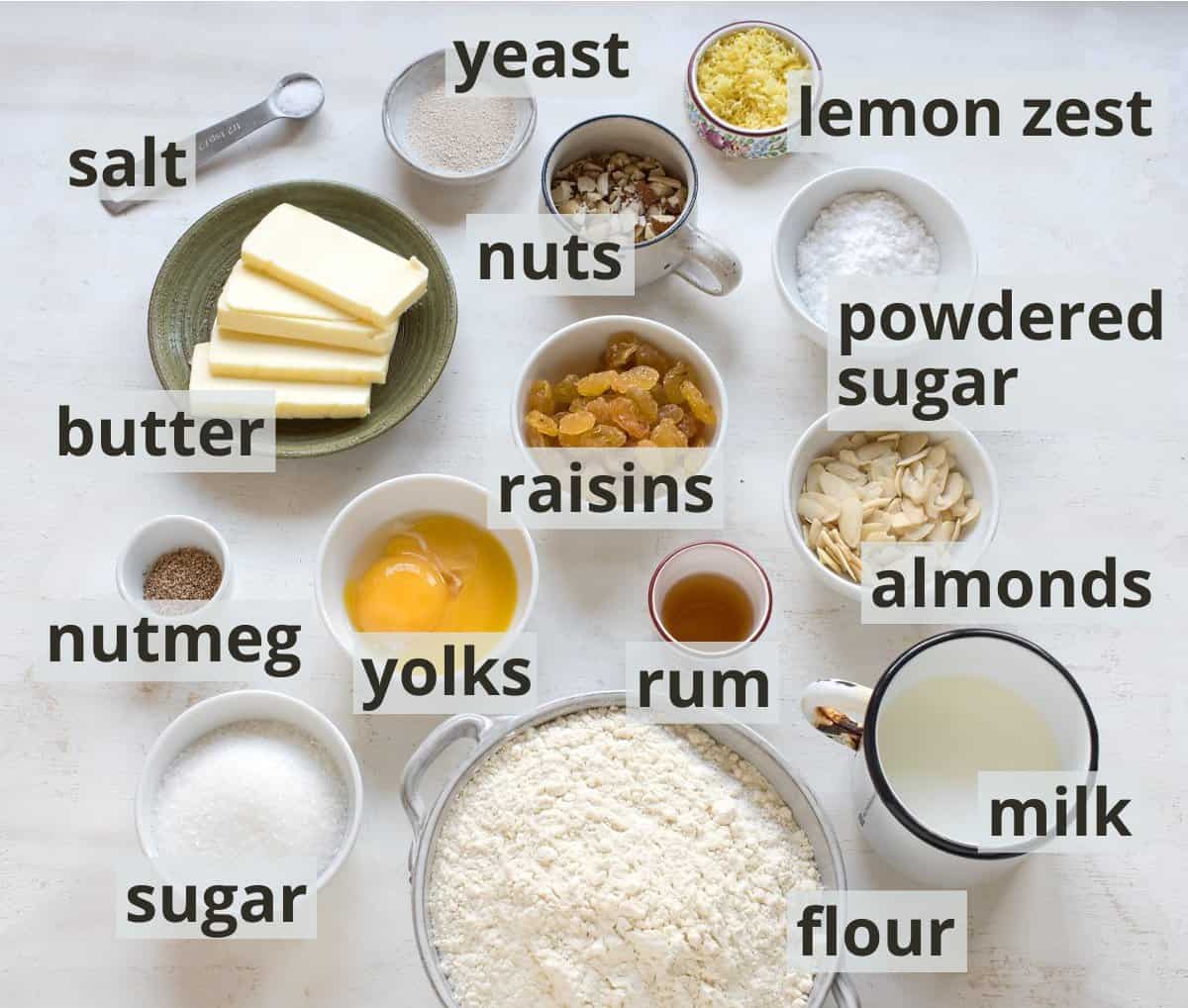
- All-purpose flour
- Milk; warm
- Active dry yeast; or fresh yeast (see details below in the recipe card)
- Granulated sugar; Vánočka is only slightly sweet, so it doesn't call for a lot of sugar
- Unsalted butter; softened at room temperature or quickly melted in a microwave
- Salt
- Egg yolks
- Raisins; golden raisins are a little bit juicier, but feel free to use regular dark raisins as well. If you like, soak the raisins in brandy overnight. They will soak in and get a great flavor.
- Nuts; ideally blanched almonds. I use a mix of natural, unprocessed nuts such as almonds, hazelnuts, walnuts, and cashew nuts.
- Nutmeg; my fav ingredient! Honestly, this spice is my little secret. Czech grandmas used to add grated nutmeg to yeasted sweet pastries, and I can confirm that it really enhances the flavor of Vánočka bread. I grate the nutmeg on a hand grater with small holes. I grate it just before I use it to keep it as aromatic as possible.
- Lemon zest; freshly grated. Use an organic lemon or wash it thoroughly under warm running water. Grate only the top yellow layer; the white tends to be bitter.
- Spiced rum; for more aroma. Czechs love their "tuzemák" or "Božkov". If you are in the USA, use Kirkland spiced rum (Costco) or the Austrian brand Stroh 54. Both most closely resemble Czech rum.
Next, you will need:
- An egg for eggwash
- Sliced or slivered almonds to sprinkle on top of Vánočka
- Powdered sugar for final dusting
Some proven Czech recipes call for pork lard instead of butter. I tried both variants, and each tasted just as good!
MY TIP: Our Czech neighbors to the west, in Germany, have a similar recipe. It's called Hefezopf and, like Czech Vánočka, it is a sweet braided Christmas bread.
➜ Video recipe
For those of you who prefer to see things in action, I have made a video recipe for baking Christmas bread. Check out my YouTube channel!
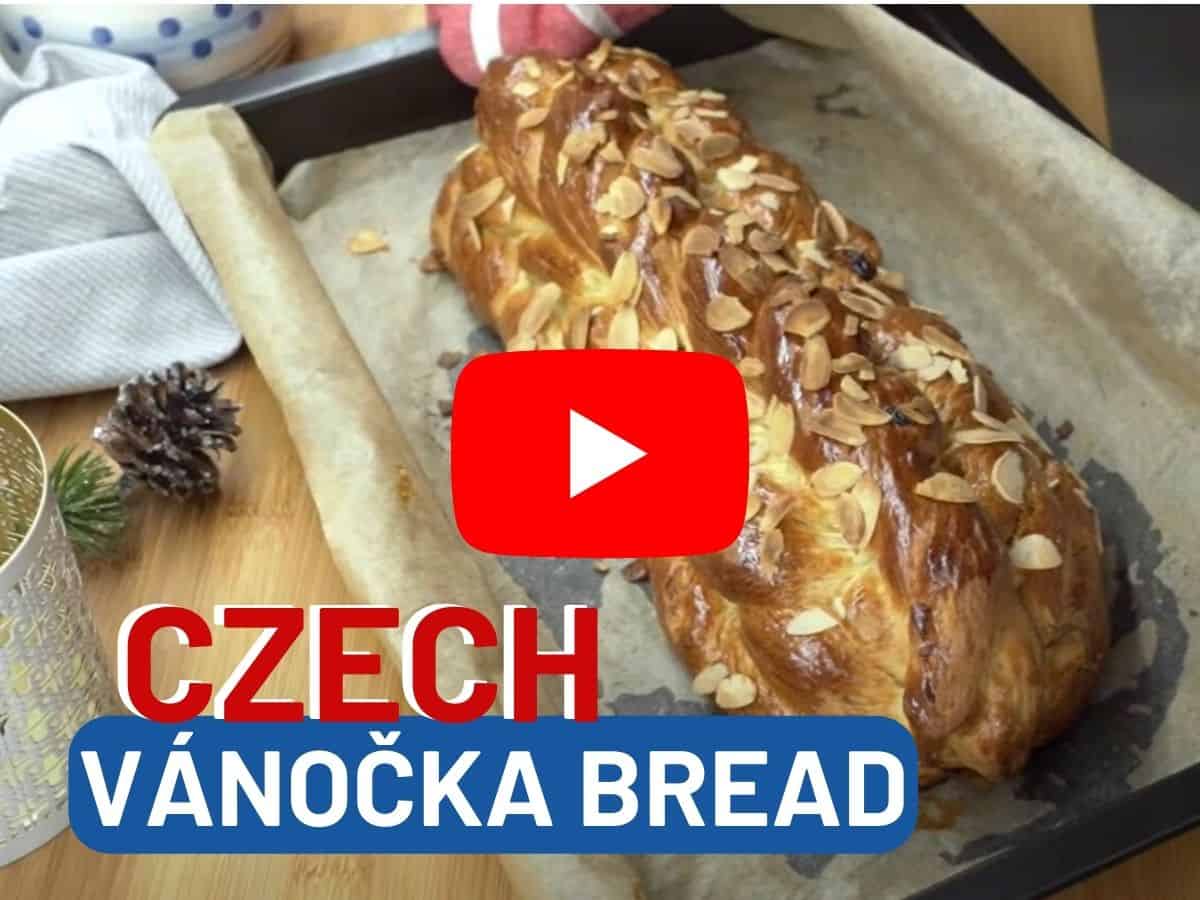
➜ Instructions
NOTE: In the instructions, I outline the process of preparing Vánočka dough using a stand mixer equipped with a kneading hook. Home bakers who have prior experience with yeast dough can prepare the dough by hand.
STEP 1: Put the flour, sugar, and active dry yeast into the mixing bowl. Add warm milk, egg yolks, and grated nutmeg. Knead for about one minute on medium speed until the ingredients are combined.
Turn off the mixer and add the soft or melted (not hot!) butter and salt. Turn the mixer to medium speed and let it work for about 9 minutes. Be patient, the fat will incorporate into the dough beautifully during this time.
Finally, add the raisins and nuts and knead on low speed for another minute, no longer.
Note: If you soaked the raisins in rum or brandy beforehand, drain them and let them drip off before adding to the dough.
STEP 2: Dump the dough onto a lightly floured surface. Shape into a ball. Transfer to a clean bowl and cover with plastic wrap or a tea towel. Let it rise in a warm place until it doubles in volume.


Note: The time it takes for the dough to rise depends on the environmental conditions and can take anywhere from one to three hours. In winter, it will take longer to rise.
To help the dough rise, place it in an oven that is turned off with a pot of hot water on the bottom. Check out my article, How to quickly rise dough in the oven.
The other option is to use a proof box. Here is my tip on one:

For perfect dough rising, I recommend this simple ✅ Dough Proofer by Czech brand Tescoma (affiliate link). I use it myself and am very satisfied!
STEP 3: Put the raised dough on a lightly floured surface and knead briefly. Divide it as follows: first in half, then divide one of the halves into about ⅗ and ⅖.
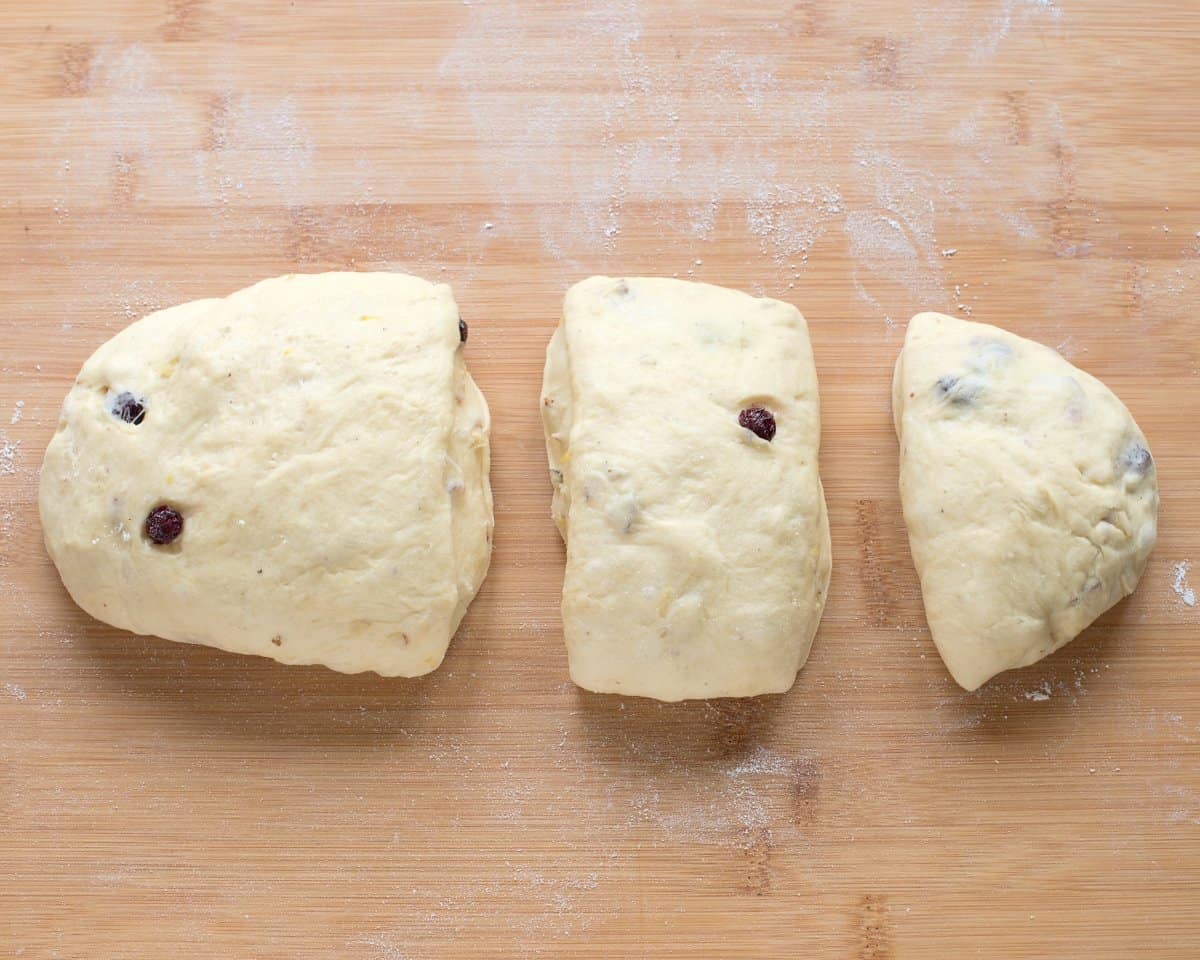
STEP 4: Prepare a baking sheet. Grease it lightly, and place parchment paper on top. The grease will make the paper stick to the bottom of the sheet and keep it from slipping off.
STEP 5: Let's start braiding the Christmas bread. Divide the dough as follows: the first half into 4 equal pieces. ⅗ of the other half in 3 equal pieces. Divide ⅖ of the dough into 2 equal pieces.
Form each piece into a small ball. Pull the dough away from the sides and press to seal over the center of the ball. Then roll the ball between your hands into a smooth, round shape and place it seam-side down.
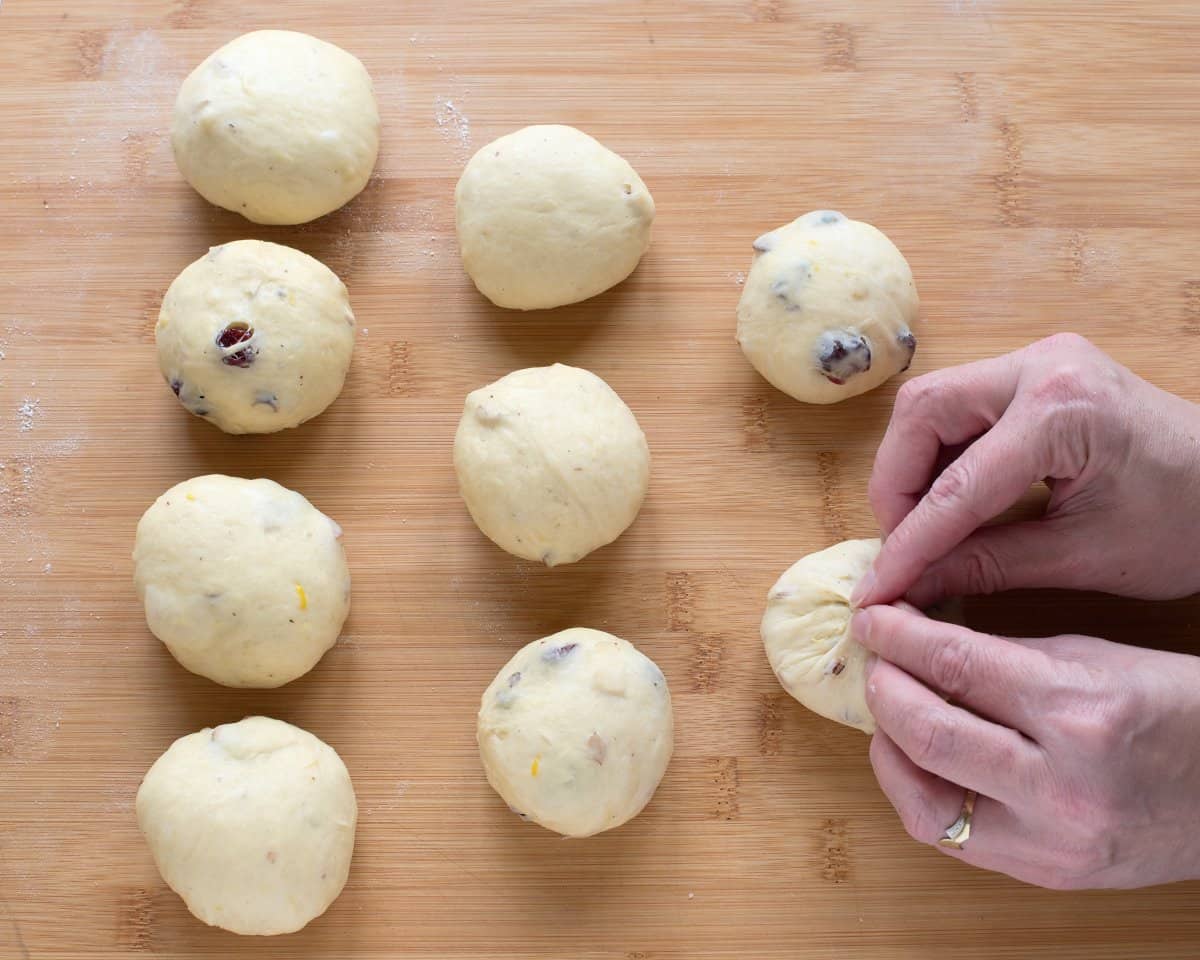
These parts of the dough will form strands that will be braided together to form the individual layers of the Vánočka bread.
The base: The base consists of four strands. To make them, roll the four pieces of dough into even lengths. Then braid the strands together.
Braiding the base from four strands is difficult to describe; a video is much more illustrative. Check out this YouTube video to see how to braid a four-strand Christmas bread base.
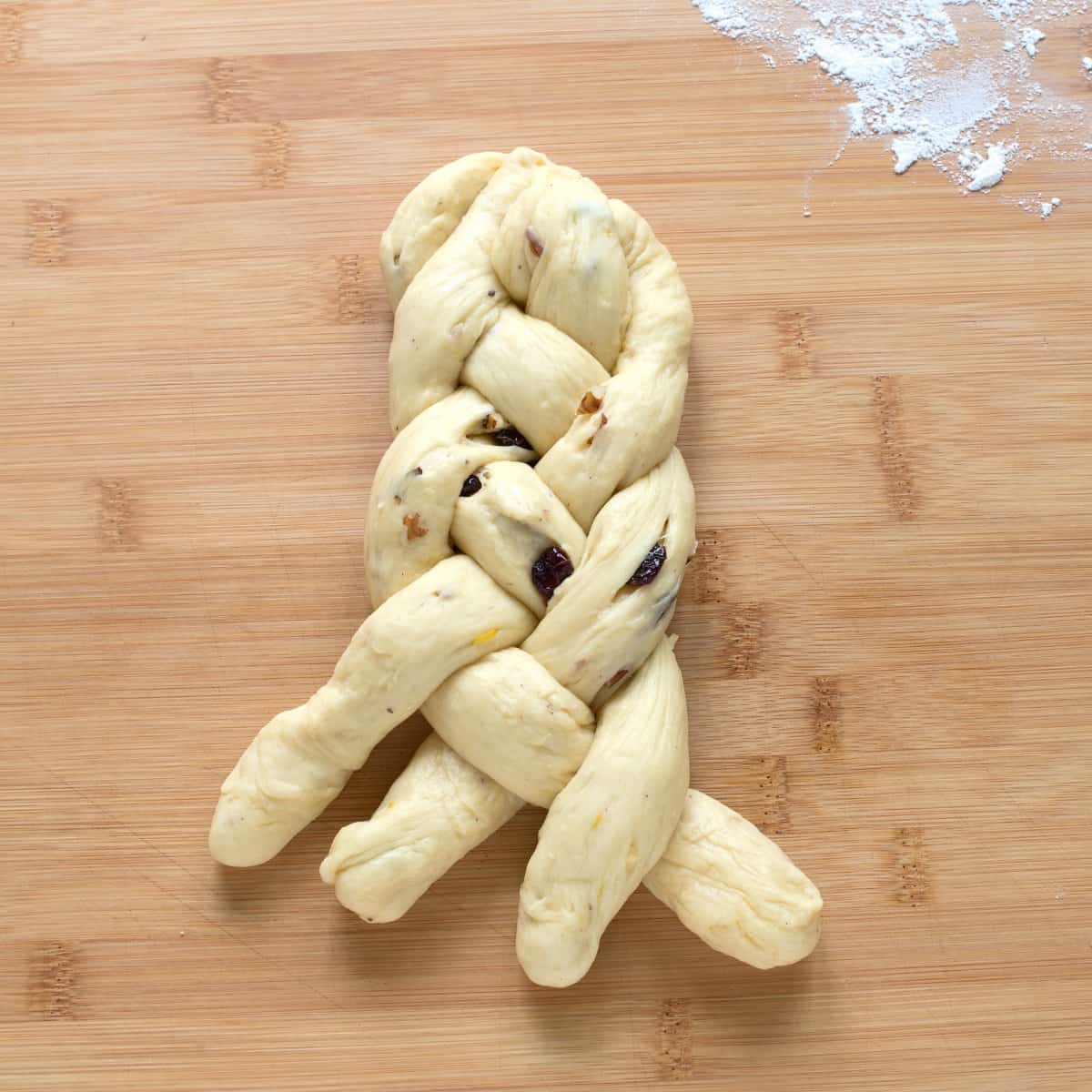
The middle layer: The middle layer of Vánočka is made up of three strands. Roll the three pieces of dough out into three equal-length strands.
Using the edge of your hand, gently flatten the center of the four-strand base. Place the middle layer of the three strands on it and press down slightly.
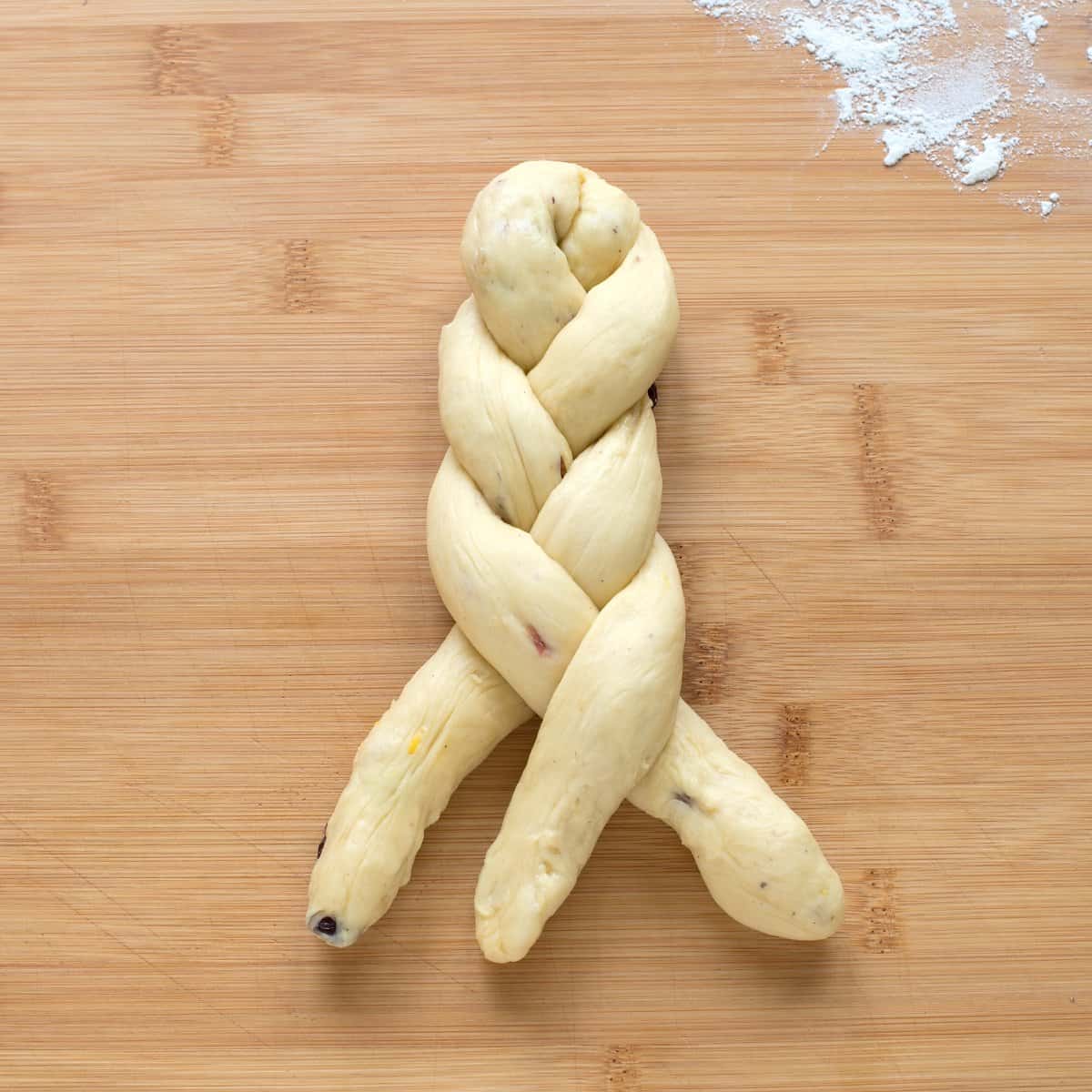
The top layer: The top layer consists of two twisted strands. Using the two last pieces of dough, roll them out into strands of equal length. Twist them together and place them on top of the Vánočka, tucking the ends under the bread.
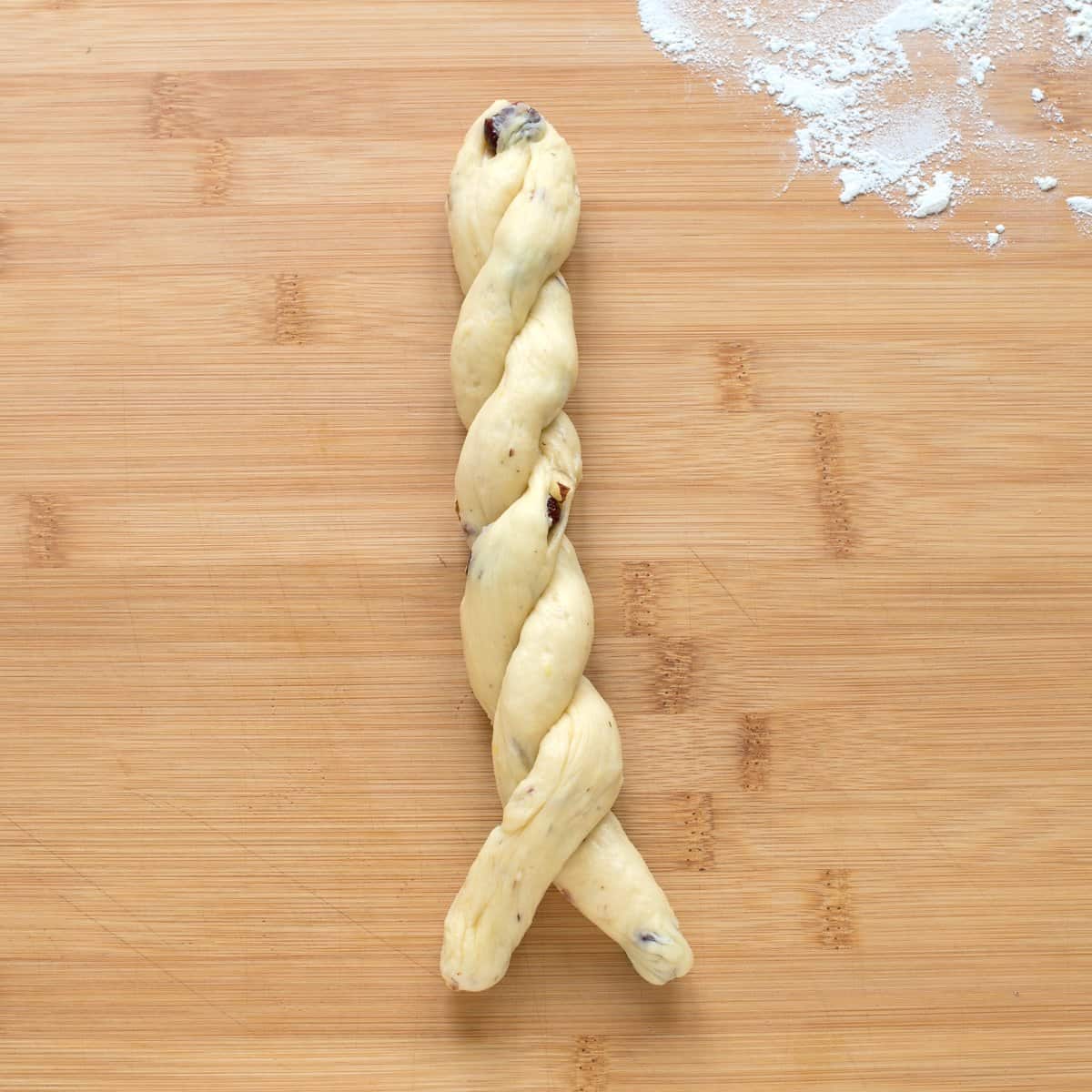
STEP 6: Let it rise in a warm place for another hour.
MY TIP: To help the Vánočka hold its shape better, stick three wooden skewers into the dough: at each end and in the middle (photo 1 below).
STEP 7: Brush the raised Vánočka on all sides with egg wash. Half an egg beaten by hand is enough for one Vánočka bread. Sprinkle the top with sliced or slivered almonds (photo 2).
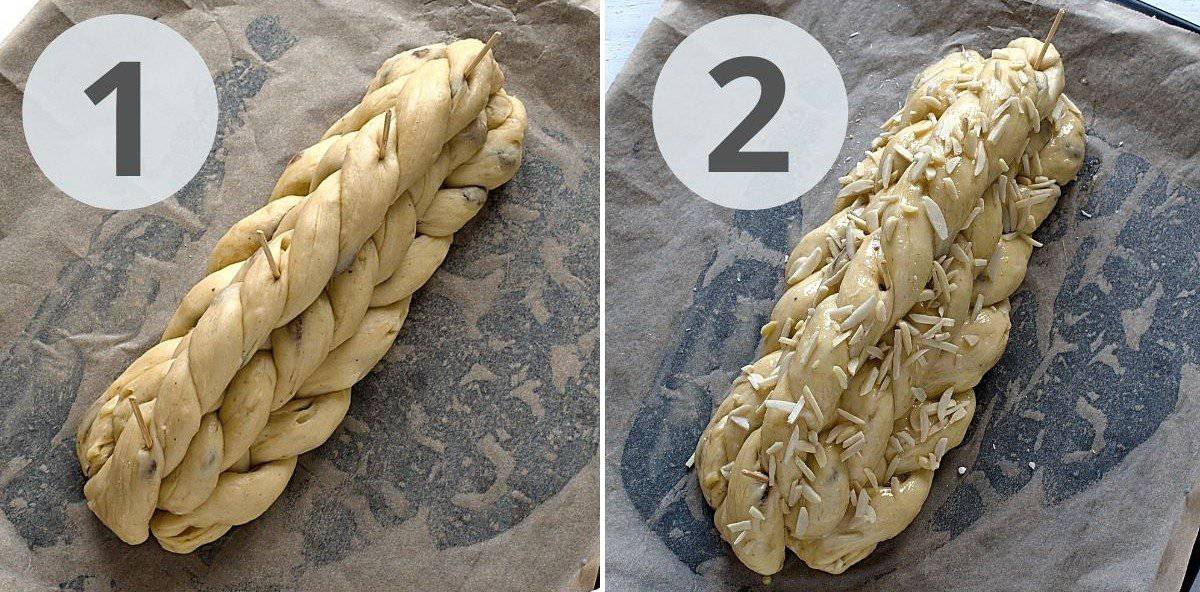
STEP 8: Preheat the oven to 400°F/200°C (conventional oven). Put the Christmas bread in the preheated oven. If you have previously inserted skewers into the bread for a better shape, do not remove them. Bake for 10 minutes.
Without opening the oven, reduce the temperature to 325°F/165°C and bake for an additional 30 minutes.
Important note: About halfway through baking, the surface of the Vánočka will begin to turn golden brown. To prevent burning, loosely lay a sheet of aluminum foil on top.
STEP 9: After about 35 minutes of baking, test for doneness. Stick a wooden skewer in the middle of the Christmas bread and pull it out. If it comes out dry, the loaf is done, and you can remove it from the oven. If there's still raw dough on it, bake the bread for another five minutes. Repeat the test until the skewer comes out clean.
Allow the finished loaf of bread to cool on the sheet for at least thirty minutes.
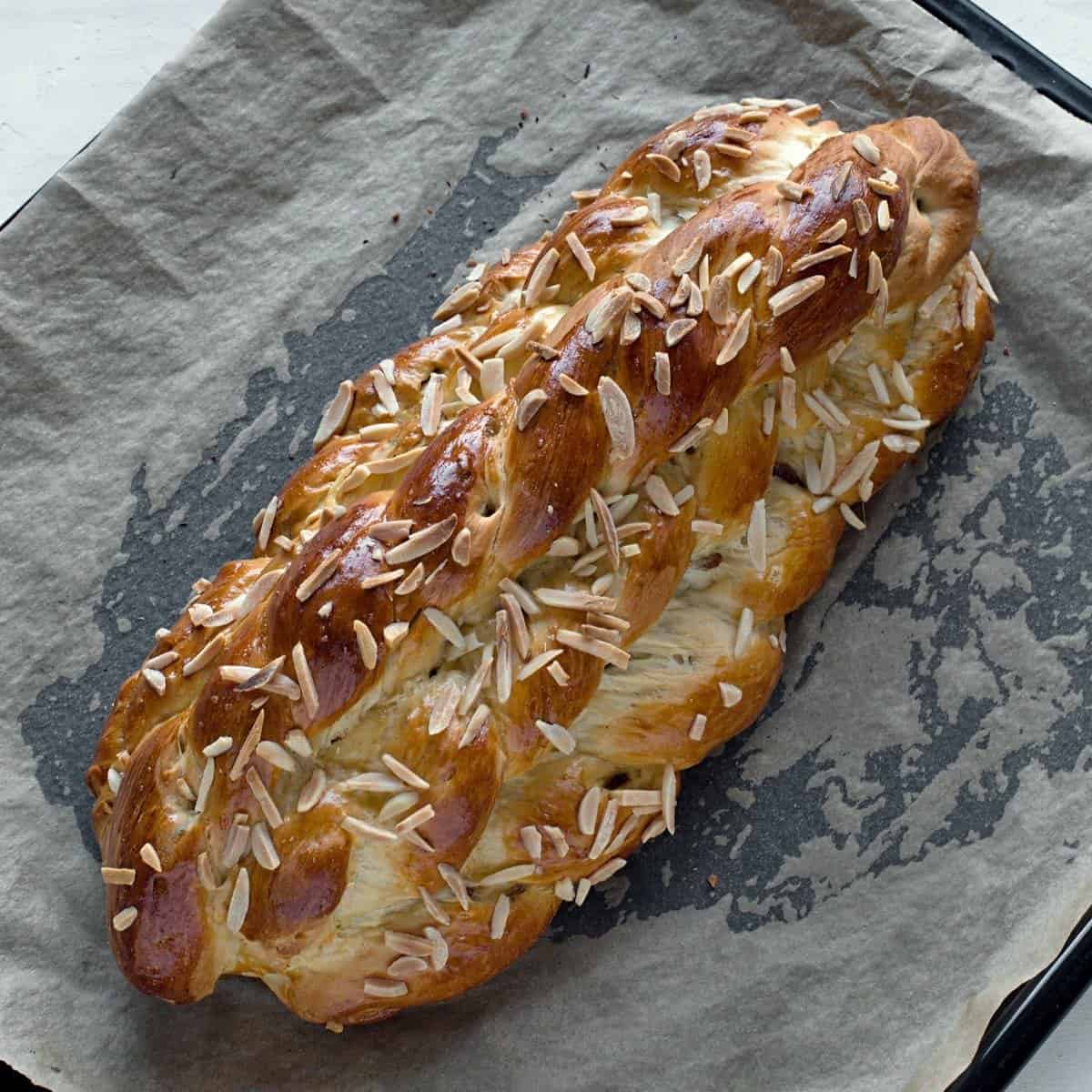
➜ How to serve Czech Vánočka (Hoska) bread
After cooling, generously dust the Vánočka with powdered sugar and cut it into slices approximately ¾ inch (2 cm) thick. Enjoy these delectable bread slices with a cup of coffee or tea.
While Vánočka tastes best the same day it is made, rest assured that it will remain moist and soft the next day. Personally, I prefer to bake it the day before Christmas and enjoy it with butter and/or jam for a holiday breakfast.

➜ The best tips to make Vánočka right
You have to knead the dough well. If you just mash the ingredients together, the gluten that makes the Vánočka airy and fluffy won't develop, and the result will be a dense and flat Christmas bread.
- Use your stand kitchen mixer with an appropriate hook and let it knead for at least 9 minutes.
- Vánočka dough contains fat (in the Czech Republic, we use unsalted butter or pork lard). As a rule of thumb, the more fat the dough contains, the worse and longer it rises because it is "heavier".
- Vánočka rises twice. The first time as a dough, and the second time as an already braided loaf. This recipe does not require the yeast to be activated (a yeast mixture) in the warm liquid beforehand.
- As the dough rises, you have to be careful that its surface does not dry out. I let the bowl of dough rise in a closed, turned-off oven with a small pot of hot water on the bottom. You can also prevent the dough from drying out by covering the bowl with plastic wrap. Alternatively, lightly dust the surface of the dough with flour and cover it with a tea towel.
- I like to stick three wooden skewers into the Vánočka to help it hold its shape: one in the middle and one at each end. The skewers are inserted into the Vánočka after it has been braided and allowed to rise for the second time. The skewers are removed only after the Vánočka is baked.
Here's a little secret: If your first try at making Vánočka bread doesn't look perfect after baking, no worries! Just sprinkle some powdered sugar on top to make it prettier. And guess what? There's no "bad" Vánočka. When you taste a slice, it still tastes amazing, no matter how it looks!
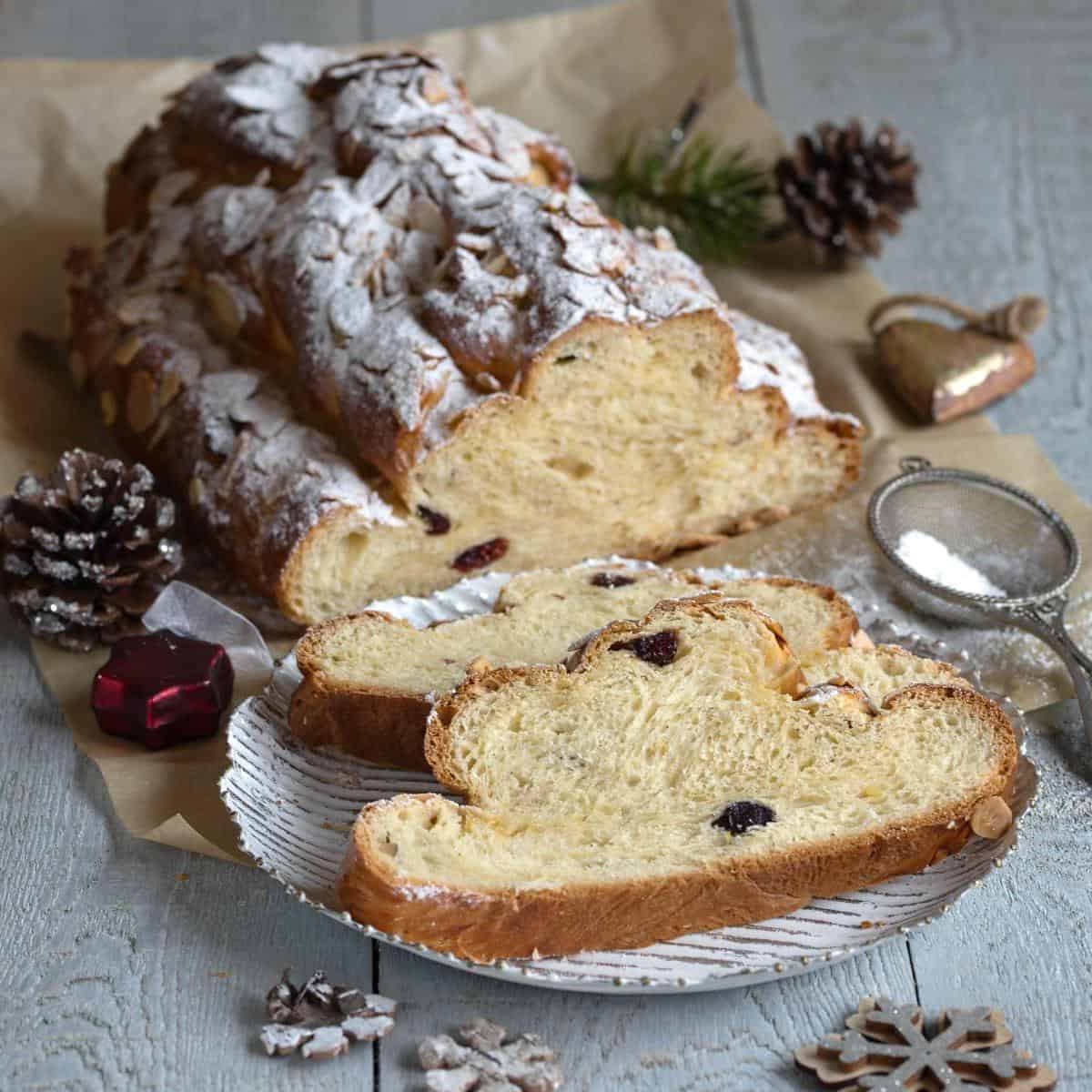
➜ Why is Vánočka braided
Cross-braiding the Vánočka has a meaning! In the past, Czechs believed that braiding Vánočka protected people from anger and rage. Vánočka is braided so that the family will have a peaceful and happy next year.
- From the baker's point of view, braided Vánočka has a better texture and is quite soft and flaky.
- The classic Vánočka is traditionally braided in three layers: the bottom with four strands, the middle with three strands, and the top with two strands. I understand that braiding with four strands can be tricky for some, so go ahead and use 3+3+2 strands instead. Just braid the bottom layer like the middle one, and you'll get a very similar result!
- If you're thinking about braiding the Vánočka with a different number of strands, I suggest watching this funny video that shows the whole process really well: How to braid Czech Christmas bread
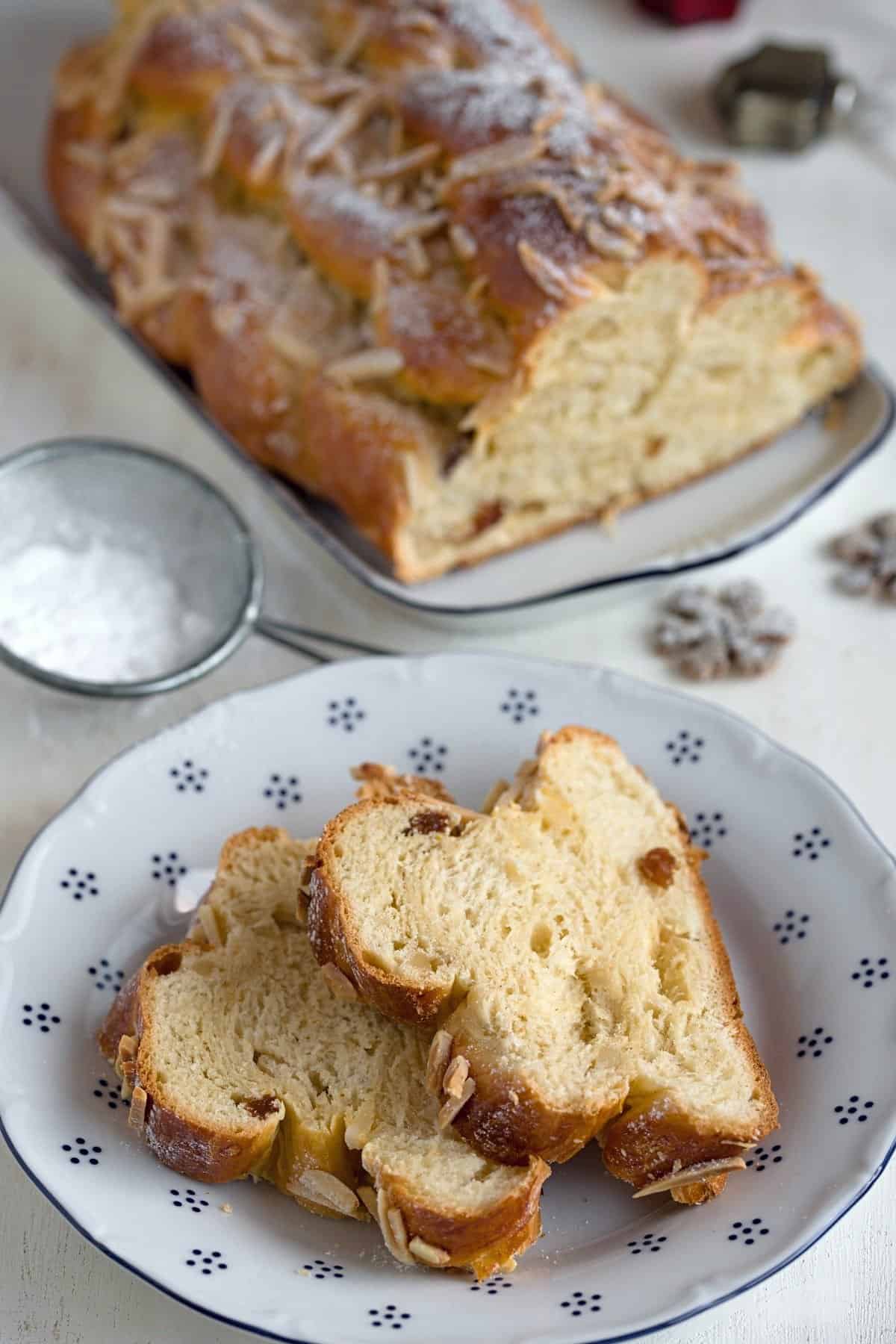
Want more of the smell and aroma of Czech Christmas? Try Czech spiced wine, called "svařák"!
➜ Pronunciation
For those who're curious about how to pronounce Vánočka correctly:
Vánočka is pronounced as: /ˈvaːnot͡ʃka/
I also recorded a short audio clip:
Vánočka is one of several Czechoslovak bread recipes. Czechs and Slovaks lived in one country (Czechoslovakia), which split in 1993 to form the separate Czech and Slovak Republics.
We still have many recipes in common with the Slovaks, such as the sweet Christmas bread - called "Vianočka" in Slovakia.
Czech Easter has its own bread, called mazanec.
➜ Superstitions around Vánočka
Something funny at the end: Czechs have a lot of old superstitions that are supposed to help them make Vánočka.
Here are three nice examples:
- The cook must wear a white apron and a white bonnet or scarf while making Vánočka.
- No one can talk in the room while the baker is preparing the dough for Vánočka.
- Children can't play and jump around the place where the dough is rising, but the baker should jump as high as he can so that the dough rises well and the resulting Vánočka tastes good!
Czech Christmas cookie recipes:
- Linzer cookies (linecké cukroví)
- Vanilla crescents (vanilkové rohlíčky)
- Beehives (včelí úly)
Tried this recipe?
Leave a review down in the comments! ⭐⭐⭐⭐⭐
Other readers and I love hearing what you think. Stay in touch by following me on Facebook and Pinterest. For more Czech stuff, subscribe to my newsletter!
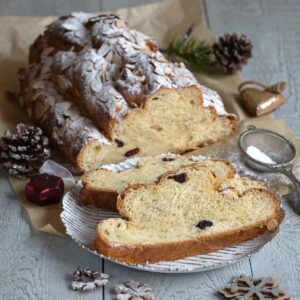
Vánočka (Houska) – Czech Braided Sweet Bread
Tap or hover to scale
Ingredients
Yest dough:
- 3 cups all-purpose flour
- ⅔ cup milk warm
- 2 teaspoons active dry yeast
- ⅓ cup granulated sugar
- ¾ stick unsalted butter softened
- ½ teaspoon salt
- 2 yolks
- ⅓ cup raisins
- ¼ cup blanched almonds roughly chopped
- ½ teaspoon nutmeg freshly grated
- 1 Tablespoon lemon zest freshly grated
- 2 Tablespoons spiced rum
To finish:
- 1 Tablespoon blanched almonds slivered or sliced
- ½ egg for eggwash
- 1 Tablespoon powdered sugar
Instructions
- Put the flour, sugar, and active dry yeast into the mixing bowl. Add warm milk, egg yolks, and grated nutmeg. Knead for about one minute on medium speed until the ingredients are combined.
- Turn off the mixer and add the soft or melted (not hot!) butter and salt. Turn the mixer to medium and let it work for about 9 minutes. Be patient, the fat will incorporate into the dough beautifully during this time.
- Finally, add the raisins and nuts and knead on low speed for another minute, no longer.
- Turn the dough out onto a lightly floured surface and form it into a ball. Transfer to a clean bowl and cover with plastic wrap or a tea towel. Let it rise in a warm place until doubled in volume.
- Place the raised dough on a lightly floured surface and knead briefly. Divide it as follows: first in half, then divide one of the halves into about ⅗ and ⅖. These parts of the dough will form strands that will be braided together to form the individual layers of the Vánočka bread.
- Prepare a baking sheet. Grease it lightly, and place parchment paper on top. The grease will make the paper stick to the bottom of the sheet and keep it from slipping off.
- Let's start braiding the Christmas bread. Divide the dough as follows: the first half into 4 equal pieces. ⅗ of the other half in 3 equal pieces. Divide ⅖ of the dough into 2 equal pieces. You will get 4+3+2 pieces.
- Form each piece into a small ball. Pull the dough away from the sides and press to seal over the center of the ball. Then roll the ball between your hands into a smooth, round shape and place it seam-side down.
- Making the base: The base consists of four strands. To make them, roll the four pieces of dough into even lengths. Then braid the strands together.
- Making the middle layer: The middle layer of Vánočka is made up of three strands. Roll the three pieces of dough out into three equal-length strands and braid them together. Using the edge of your hand, gently flatten the center of the four-strand base. Place the middle layer of the three strands on it and press down slightly.
- The top layer consists of two twisted strands. Using the two last pieces of dough, roll them out into strands of equal length. Twist them together and place them on top of the Vánočka, tucking the ends under the bread.
- Let the braided bread rise in a warm place for another hour.
- Brush the raised Vánočka on all sides with egg wash. Half an egg beaten by hand is enough for one vánočka bread. Sprinkle the top with sliced or slivered almonds.
- Preheat the oven to 400°F/200°C (conventional oven). Put the Christmas bread in the preheated oven. If you have previously inserted skewers into the bread for a better shape, do not remove them. Bake for 10 minutes.
- Without opening the oven, reduce the temperature to 325°F/165°C and bake for an additional 30 minutes.
- Important note: About halfway through baking, the surface of the Vánočka will begin to turn golden brown. To prevent burning, loosely lay a sheet of aluminum foil on top.
- After about 35 minutes of baking, test for doneness. Stick a wooden skewer in the middle of the Christmas bread and pull it out. If it comes out dry, the loaf is done, and you can remove it from the oven. If there's still raw dough on it, bake the bread for another five minutes. Repeat the test until the skewer comes out clean.
- Allow the finished loaf of bread to cool on the sheet for at least thirty minutes.
Notes
- Makes 1 Vánočka bread.
- NOTE: In the instructions, I outline the process of preparing Vánočka dough using a stand mixer equipped with a kneading hook. Home bakers who have prior experience with yeast dough can prepare the dough by hand.
- MY TIP: To help the Vánočka hold its shape better, stick three wooden skewers into the dough during rising and baking: at each end and in the middle.
- SERVING: After cooling, generously dust the Vánočka with powdered sugar and cut it into slices approximately ¾ inch (2 cm) thick. Enjoy these delectable bread slices with a cup of coffee or tea.
- STORAGE: Cover the bread with a clean tea towel or loosely with plastic wrap, it will last about 4-5 days on the kitchen counter. The bread also freezes well. Put the whole loaf or slices in a freezer bag and place in the freezer. It will keep for about three months.
- If you are an American with Czech roots, you may know Vánočka as Houska or Hoska. That's because, historically, Vánočka was called Houska in the old Bohemian world.



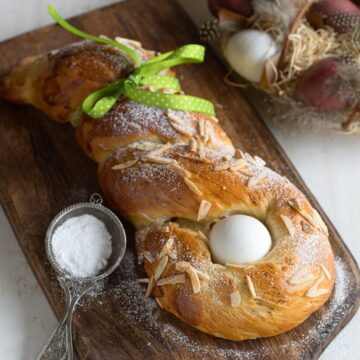
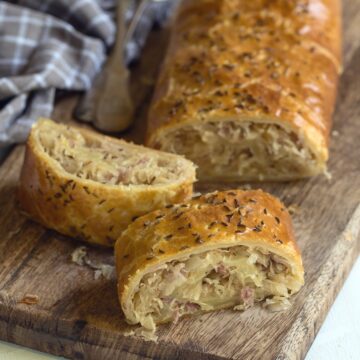
Michael Lloyd of family Zajicek, Liberda & Havran says
Very, very close to my Grannie's recipe. Her grandfather and his sister emigrated to Texas in the 1870's and settled around Lagrange. I was told they had run a bakery in Praha, but they farmed here. Grannie's recipe did have a few differences: currents rather than raisins, added a bit of nutmeg and another egg and she used AP and bread flour, about 4 to 1. She also braided 9 pieces, 4 on bottom, 3 in middle, 2 on top. We loved the "Christmas Twist" so much, my brother and I once devoured an entire loaf one afternoon, toasting and buttering slice after slice! Grannie just laughed, luckily she and Mom had made several more and were planning on at least 2 more. They had to go get more ingredients, so they made 3 more!
Petra Kupská says
Ahoj Michael, thank you so much for your comment, I have to smile here, I love memories like this! 🙂 We all know that vánočka Christmas bread tastes best fresh out of the oven, same here, at least one is eaten the same day it's baked. Thanks also for mentioning the ingredients your Granny used. Nutmeg was common in baking sweet pastries in our country and is sometimes found in old Czech recipes even now. Sending many greetings to Texas, Petra
Sandy says
Petra, thank you so much for finally clearing up a dispute we have been having in our family. The difference between houska and vanocka. I am 70 years old and my parents and grandparents have always called this braided bread houska. My grandma was born in Moravia in 1903 and always called it houska. Recently my daughter-in-law decided to make this and searched the web for recipes. She told me that this bread was called vanocka. I am glad to know now that we are both correct. Thanks!
Petra Kupská says
Of course, you're both right! 🙂 I was also surprised at first because, in today's Czech Republic, a houska means a more miniature braided pastry that is salty. But then I found out that in the past (around the turn of the 19th and 2nd centuries), the name houska was used to refer to today's vánočka bread! I have to say that I am excited about such findings, and I am very interested in how the Czech language evolves over time.
sue kepka says
so wonderful to find this recipe, thank you. My mum went to Czechoslovakia with my dad, a Czech pilot after the WW2 and learnt how to make Vanochka . I remember always loving it. Mum died two years ago and in latter years was unable to make it. I am going to have a go!
Petra Kupská says
Ahoj Sue, thank you for your lovely comment! My fingers are crossed that the Vánočka Christmas bread is a success. I believe you will enjoy it! Krásné Vánoce from Bohemia ????
Marian says
We found this recipe last year and made it after years of using others and not being totally happy with the results. Our vanocka was great and can’t wait to get started on this year’s.
Petra Kupská says
Ahoj Marian, many thanks for your kind comment, it made me happy ???? I'm glad the Vánočka bread was a success! Krásné Vánoce (Merry Christmas) for you and your family ????
Tim says
Petra,
This sounds similar to a bread my grandmother, whose parents moved to the U.S. from Czechoslovakia sometime around the turn of the century, made every Christmas. She called her bread "buthda" (that's how it sounded, anyway, but I'm not sure of the spelling). Any ideas what this is? I've never made it, but I recently asked my sister for the recipe. I remember it has some type of candied fruit in it instead of raisins soaked in rum overnight. I remember liking it. My father remembers toasting it when he was a kid. This might have been due to the fact that it seemed to dry out quickly. I'm just curious if you, or anyone else reading, might know what bread I'm talking about. Thank you!
Petra Kupská says
Ahoj Tim,
Thank you for your lovely comment. I wonder what kind of pastry your babicka (grandmother) might have made called 'buthda'. The name reminds me of the Czech word 'buchta', which is a generic term for a sweet pastry baked on a baking sheet (a sheet cake). The batter is poured onto a baking sheet and covered with fruit. Here is an example: Bublanina fruit cake
Another option is 'buchty', made with yeast dough and filled with fruit, cream cheese (tvaroh), or poppy seeds. Here is the recipe: Czech buchty
Could any of these be what you're looking for?
Veselé Vánoce and Merry Christmas from Bohemia to you and your family! Petra
Maggie Josefy says
My mom passed down a vanocka recipe to me and my daughter. She always used citron,( candied fruit) and raisins. I hope this helps.
Sigrid Skarda says
Ahoj Petra,
just found your web side by googeling for Buchty. What a nice find.
I have been cooking for my Czech husband for many years, but it's great to have a different cook as an example. I'm German and learned Czech cooking from my husband's memory of his moms cooking. He is from the Plzen region. It's not the same as having real Czech cooing lessons.
Maybe he will like your Buchty better, didn't know about the rum.
Vesele Vanoce from California.
Sigrid.
Petra Kupská says
Ahoj Sigrid,
Thank you so much for your kind comment. Buchty is a typical Czech pastry, maybe a bit more challenging to prepare, but definitely worth a try!
Regarding the rum, in the Czech Republic, we use a specific rum, which is actually not even rum. If you are based in the US, I recommend Kirkland spiced rum (available at Costco) or Austrian Stroh 54. Brushing the buchty buns with rum gives them a delicious final taste.
Veselé Vánoce, Merry Christmas and frohe Weihnachten! 🙂
P. S. Plzen (Pilsen) is world-famous for the production of great Czech beer ????
Milena Bartik says
I have been baking vanocka for years, so this christmas i tried yours, so far everything that I made from your website worked out well, but vanocka not so much. Taste was amazing, but dry and crumbly, what did I do wrong. I will keep trying over and over, until I get it right, but maybe you can give me some pointers.
Petra Kupská says
Milena, I am so sorry to hear this. It’s my fault! This recipe for vanocka bread was one of the first ones I shared on the blog. I still lacked experience in accurately converting metric measurements to the US imperial system. This year I baked 8 vanockas in succession, tweaking the dough, baking time, and keeping careful notes of everything. I think I now have a very good recipe with a whole process. I just need to write it up and post it (the damn lack of time!). But you speak Czech without any problem, don't you? 🙂 I have the recipe already written in the Czech language here: https://www.klasicke-recepty.cz/vanocka/
According to the old cookbooks, I started adding grated nutmeg to the vanocka and the resulting taste pleasantly surprised me. I apologize again, now you've pushed me to modify the recipe here!
Zdravím tě moc z Čech, Petra
Milena Bartik says
No apology needed, I will definitely try the link, just because something don't work out, it does not mean that I will give up. Your vanocka looks so delicious. As a matter of fact Im printing your recipes right now, because I told my husband that this week we will eat only czech.
Petra Kupská says
Oh, thank you for your words! How is the week with Czech food going, is it a success? 🙂
Jill P. says
Hi, Petra! My grandmother’s family were Czech immigrants around the turn of the century and she also called this houska! My grandmother made this every Christmas (along with kolaches) and we do looked forward to it. She was never able to write down what she did but I found a recipe that tastes like I remember hers tasting. It includes mace which might be similar tasting to nutmeg? Anyway, my family asks for houska year ‘round so I make it a few times a year! Really enjoying your website—thanks so much for all your stories, recipes and tips!
Petra Kupská says
Ahoj Jill, thank you so much for your nice comment! It's the same everywhere: moms and grannies cook by eye, thanks to years of practice, they don't need any written recipes 🙂 I always grate a bit of nutmeg into my Christmas houska, but unfortunately, I have no comparison to mace.
Barbara says
Can I use a bread machine for the mix, knead and rise? I will put ingredients in the bread machine in the order suggested in my owner's manual. Also, what is the measurement for the vanilla? And do I put in zest of one whole lemon? Thank you.
Petra Kupská says
I think you can make this vanocka in your bread machine without any problems. Add about half a teaspoon of vanilla essence or vanilla paste to the batter, depending on what you have in your pantry. I put lemon zest grated from about half to a whole mid-sized lemon, it doesn't make that much difference. Good luck and happy holidays!
Carey Jasa says
Hi!
Just like so many others, my grandmother made this recipe. She, too, called it Houska. And my recipe from her includes instructions like “enough dough to make…”. I’ve figured out amounts by trial and error. She would add the spice mace instead of nutmeg and I like that in kolaches also. Question: can the dough be refrigerated or frozen to bake later? Or better to bake two smaller loaves and freeze the baked bread? Thank you!
Petra Kupská says
Hi Carey, because the dough contains live yeast, it should not be frozen. Ideally, bake the houska bread, let it cool, and freeze it as soon as possible. If you want to take out individual portions, it is even better to slice the baked houska before freezing.
Tim J says
I just made this. Very tasty. I don't have a Czech grandmother, and I have never had this from a Czech bakery, so I'm not sure how close to the recipe mine came out. It was a little dry to my taste, but whether that was a fault in my baking, or exactly how it should be, I don't know. I note that th recipe as written does not list the amount of lemon rind or vanilla extract to use. I looked at the Czech version of the website, and it looked like about 1 teaspoon of each, that that was what I used. It was also very difficult to mix in the raisins and chopped almonds into the dough after kneading it for 10 minutes in a stand mixer. I don't know if you could offer some suggestion there. Thanks.
Pavel says
I remember Vánočka from when I was a kid in Czechoslovakia. My mother was a well regarded baker and after we moved to the West she always lamented that the taste was terribly different. It is the wheat that is/was available here in the USA. Vánočka requires very high gluten content flour. 14 percent protein is a good start if one can find it, and I believe it requires white winter wheat as well, if you want something near authentic. Btw, Houska is a regular bread roll. There is no relationship there. Looking at the slices in your photo, I can (sadly) assure you that what you have is not vánočka, though I am sure it is delicious in it's own way. I am glad that you chose to highlight this food, criticisms notwithstanding. It has religious connotations, or used to have, and was quite important to the Christmas traditions of the country. Cheers.
Mandy says
Hmm... I'm wondering what I've been eating for the past 17 years living in the Czech Republic if this isn't Vánočka.
Anicka Cooklikeczechs.com says
Thank you so much for your feedback!
Yes, the choice of flour is important for a good baking result and I believe that US flour can taste different than Czech flour.
As for baked goods being referred to by the word Houska, I know there's endless bantering in many discussions about Czech food. What we Czechs currently call a houska is a type of palm-size braided roll of neutral flavor. The old Czechs of the late 19th and early 20th centuries used the word Houska to refer to what is now called Vanocka (Christmas bread). And that is just fine.
William Milan Uhlarik says
I was born and raised in Chicago in the 1950's; however, my parents immigrated to the U.S. after the war from what is now known as Slovakia but formerly known as Czechoslovakia before the country split into two separate republics. My mother and grandmother would make the Christmas Bread for the Christmas Season which we called Vianočka (or Vánočka in Czech). During other times of the year, they made a somewhat simpler version which we called žemľa (or houska in Czech). In my Chicago neighborhood, the majority of people were immigrants from Czechoslovakia or first generation. We had many Czechoslovak bakeries that made and sold this delicious bread. My mother and grandmother used the softer yellow raisins instead of the harder black raisins. Most the bakeries also used the softer yellow raisins. I moved to south coastal Texas about 20 years ago, and I still make Vianočka for my family. Thank you very much, Petra, for sharing this delicious recipe of our Czechoslovak heritage so we here in the U.S. can continue to enjoy our culinary heritage.
Anicka Cooklikeczechs.com says
Hello William, thank you so much for sharing these memories - they sound truly lovely.
Greetings from the Czech Republic.
Kathy says
Hi,
My mother-in-law was from Czechoslovakia. When my late husband and I got married all he asked for was that I learn to make bread dumplings. I did and he was happy. The weekend after Christmas I always fixed him jaternice and scrambled eggs for breakfast. Along with it was Houska. I never ate the jaternice then but now every couple of months I have it for Sunday breakfast. He unfortunately passed away several years ago. I am going to try this recipe because my whole family loves Houska. thank you for all the wonderful recipes.
Anicka Cooklikeczechs.com says
Hello Kathy, thank you for your comment and sharing your memories - I am sorry about your husband.
I am glad you like the recipes! Greetings from the Czech Republic.
Ann Wiegers says
My grandparents' neighbors were Czech and I learned to make "houska" when I was 13 and it is not really Christmas without it. The recipe and braiding method are very similar, but I and they used mace, not nutmeg. For me, the mace has to be there. I also use candied lemon peel as well as raisins and almonds.
Anicka Cooklikeczechs.com says
Thank you for your comment and feedback, Ann!
Olga Jandera says
Hi Petra,
Thank you for posting the Vanocka recipe. I was born in Prague, our family left Czechoslovakia in 1968. I've been making Vanocka for over 20 years, though I have an adapted recipe to be used for a bread maker, which I only use it to make the dough, then I incorporate the raisins in after. I do the four braid then two three braids, I will try your twist for the top. I'm looking forward to adding nutmeg, though I do add Anise seeds to the dough. I will also try and soak my raisins in rum, great idea. Thanks so much for the history of Vanocka,
Anicka Cooklikeczechs.com says
Ahoj Olga, thank you so much for your comment and feedback (glad you enjoyed the history part :)). I am happy to hear that - please let me know how the Vanocka turns out afterwards!
Greetings from the Czech Republic.
Daniella says
thanks so much for sharing this recipe--I am trying to rediscover my Czech roots.
In the recipe ingredients list, you list lemon zest and spices rum, but there is no mention of it in the actual directions
Karen Coy says
Thank you very much for sharing this recipe. My great-grandparents immigrated to the United States from Mýto in the 1890's. My grandmother always made Vanocka at Christmas. I am very excited about making it for my children and grandchildren this year.
I saw in a comment from last winter that the measurement needed to be corrected because the bread was too dry. Are the ingredients listed now correct? I don't want to spend the time if it isn't going to be soft and delicious.
Karen Coy says
I did a practice loaf this weekend. It is wonderful. Light, flavorful, and beautiful to look at. It reminds me of Christmas at my grandparents as a child. Thank so much for the detailed instructions. I watched the video several times. The pictures were very helpful also. Thank you!
Anicka Cooklikeczechs.com says
Ahoj Karen, thank you for your comment and kind words!
Greetings from the Czech Republic.
Sheila says
Hello Petra! Your vanocka recipe is as good or better than my mother-is-law's recipe and she grew up in Moravia! Very easy to follow and, when the butter incorporates, a beautiful yeast dough appears like magic! I don't have a kitchen machine but kneading the dough by hand is just a bit longer process - I use the windowpane method to tell if the gluten has been formed. I rely on your website for awesome Czech recipes and you never disappoint - thank you so much!
Petra Kupská says
Thank you, Sheila, for your kind words! I am glad that the Vánočka turned out well.
Frank Miller says
My mother used to make this every Christmas and Easter. I still use her handwritten recipe, which she got from her mother. I love it sliced, toasted, and buttered with a cup of coffee for breakfast.
Anicka Cooklikeczechs.com says
Thank you for the comment and sharing nice memories, Frank!
Noreen Sorensen says
Thank you for sharing this houska recipe! My grandmother would make a loaf just about every week. When she passed away at age 89, I looked thru her recipe cards to find her houska recipe. To my astonishment, the entire recipe was in Bohemian; hence, I could not read it! So looking forward to baking this bread in my cottage in northern Michigan! Merry Christmas! PS -- she also made delicious plum coffee cake and plum dumplings....any recipes for these???!!!
Petra | Cook Like Czechs says
Thank you so much for sharing that beautiful story about your grandmother. I can only imagine how special it will be to bake the houska in her honor at your cottage in Michigan.
As for the plum coffee cake and plum dumplings, I have "Plum Dumplings with Poppy Seeds" and "Plum Streusel Coffee Cake" on my page. I hope they are what you are looking for.
I hope you had truly Merry Christmas 🙂
Natalie says
My mother grew up eating this in New York. Hew family would buy it every Christmas from a little bakery down the street. When she married my dad and moved to Texas, she missed it so much that my dad went to the local library and searched the card catalog to find a recipe for it. He finally found one and he made it every Christmas for her until she passed away four years ago. We, their kids, all have photocopies of that original recipe he found in the library. I’d like to know, can I make the dough the night before and cold proof it overnight in the refrigerator? It seems it would work, as it is similar to brioche.
Lynn Vavra says
How would I adjust this recipe for high altitude? I’m at 5,280 feet in Denver, Colorado (USA) and last attempted a Czech nutroll with yeast. I called them “bombs” since they blew up to 2x normal size, yikes. I know flour, leavening, liquid and of course yeast can respond to higher altitudes. Baking time & temperature also factors. Advice?
Cheryl Fielitz says
Hello! My family has Czech heritage living in America. I grew up eating Houska every Christmas. I am the Houska baker now, and I am trying this recipe for the first time. I am wondering when to add the rum and the lemon zest to the dough--I don't think it says in the recipe. I didn't notice it until I was ready to add the nuts and raisins, so I just added it then and kneaded in a little more flour to make the dough less sticky. It is doing it's first rise right now, so I have no idea how it will turn out!
I do really enjoy your website though, after visiting Prague several years ago, I am more interested in my Czech heritage so these recipes are wonderful! Merry Christmas from Minnesota!
Laly says
Hello, great recipe. I'm following you from Spain. Could you tell me how much butter to use? Here there are many bars of different weights. Thank you very much.
Petra Kupská | Cook Like Czechs says
Hi! In the Czech Republic, butter typically weighs 250 grams per bar. So, 3/4 of the butter would be 187.5 grams.
You are very welcome, and sending greetings from the Czech Republic!